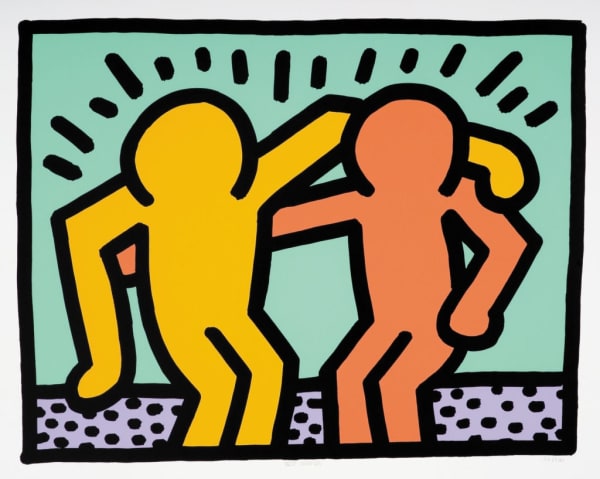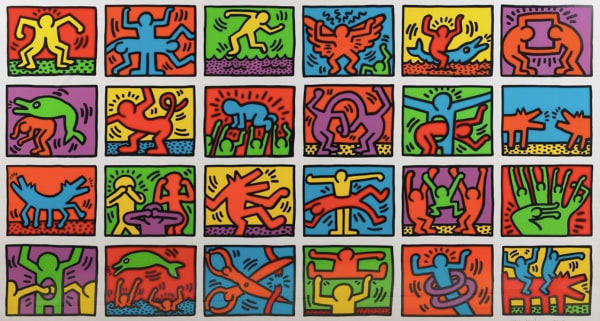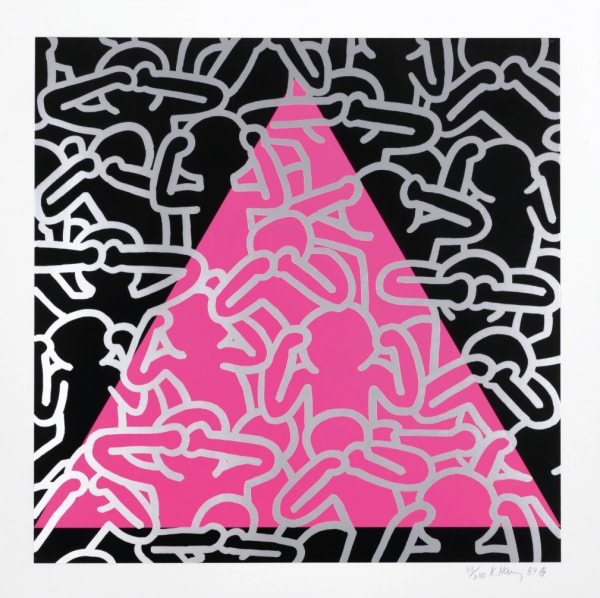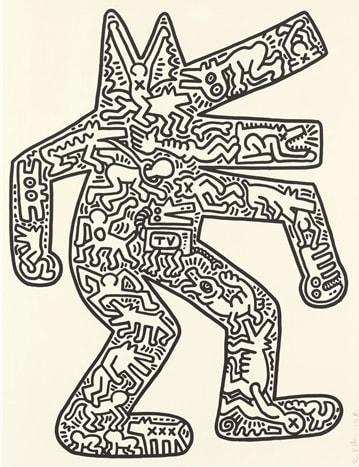
Keith Haring
95.3 x 71.8 cm
Keith Haring’s Dog motif, featuring canines with their mouths open mid-yap, is one of the street artist’s most universally recognizable symbols, and remains a testament to his dedication to accessible art. “Art is nothing if you don’t reach every segment of the people,” he once said. The dog’s simple, cartoonish shape references Haring’s interest in Egyptian hieroglyphics, an example of how humans communicate their experiences through universal shapes and signs.
Keith Haring's 1986 rendition of the Statue of Liberty pays a heartfelt homage to this cherished and powerful symbol, which holds profound significance for multitudes. The artwork, vividly bathed in striking green hues, portrays the stately Lady Liberty—a guiding light for weary travelers. Her posture is poignant, one arm clasping the tabula ansata, bearing the adoption date of the Declaration of Independence, “JULY IV MDCCLXXVI,” symbolizing law and principles. In her raised hand, she proudly holds a torch, its simplistic yet commanding flame signifying liberty's illumination and the onward march of progress. At the artwork's base, three of Haring's distinctive caricatures dance and exuberantly wave their arms overhead. The fluid lines surrounding their hands imply movement, a symbolic representation of our perpetual pursuit and celebration of the joys of liberty. This artwork commemorates the centennial anniversary of the Statue of Liberty's arrival as a gift from France, serving as a symbol that warmly welcomes millions while embodying hope and promise for those seeking a new life in America.
Retrospect stands as a remarkable testament to the artist's creative brilliance. This silkscreen print bursts with iconic elements drawn from his most renowned works. Aptly named Retrospect, the print showcases references to Haring’s most identifiable motifs, including barking dogs, angels, radiant babies, and dancing figures—symbols recurrent in the artist’s extensive career. Comprising twenty-four rectangular boxes, the composition unveils intensely vivid and colorful scenes. Within each scene, Haring's iconic black line figures portray various forms of movement and interaction. The collective artwork amalgamates these twenty-four smaller compositions, offering viewers a comprehensive overview of Haring’s artistic repertoire. Retrospect vividly demonstrates Haring's adeptness in manipulating color and line to craft compelling designs that addressed significant societal issues related to race, sexuality, and violence.
Keith Haring's Silence Equals Death, created in 1989 during the concluding years of the artist’s life, stands as a remarkable testament. It's an adaptation of the influential political poster created for the Silence=Death Project, an activist collective from which the artwork derives its title. The original poster, displaying a vibrant pink triangle against a solid black background, served as a pivotal symbol in the group’s advocacy against the AIDS epidemic. The pink triangle, initially used by Nazi Germany to identify gay men and transgender women, has been reclaimed by the LGBTQ community as an emblem of pride.
Haring’s rendition prominently features a sizable pink triangle that dominates most of the composition, set against a solid black backdrop. Silver ink renderings of numerous figures, symbolizing the adage “hear no evil, see no evil, speak no evil,” overlay the entire artwork. This creation articulates profound dissatisfaction with the Reagan administration’s silence and suppression regarding discussions on the AIDS crisis, which resulted in numerous deaths within the queer community. Notably, Haring completed this work one year following his devastating AIDS diagnosis, mere months before his untimely passing in 1990.
Keith Haring’s Best Buddies, created in 1990, stands as one of the most instantly recognizable symbols worldwide. The artwork features two simple figures locked in an embrace at the center, enveloped by rays emanating from their shared hug—a truly heartening image. The background remains uncomplicated, portraying a sky and a dotted ground, purposefully directing attention to the foreground where the two figures and their serene bond take center stage. Engaging in an embrace while seemingly facing each other, they share a moment steeped in mutual compassion. Rendered in various colors, Haring’s trademark outlined figures, devoid of distinct facial features or gender markers, serve as universal representations of humanity, underscoring the significance of fostering inclusivity and embracing differences. This open-endedness invites viewers to project themselves onto this embrace, making it a potent symbol of friendship and love with a far-reaching impact. The intertwined arms of the figures in "Best Buddies" exude hopefulness, symbolizing the very best of human connection.
Join our mailing list
* denotes required fields
We will process the personal data you have supplied in accordance with our privacy policy (available on request). You can unsubscribe or change your preferences at any time by clicking the link in our emails.
This website uses cookies
This site uses cookies to help make it more useful to you. Find out more about cookies.




